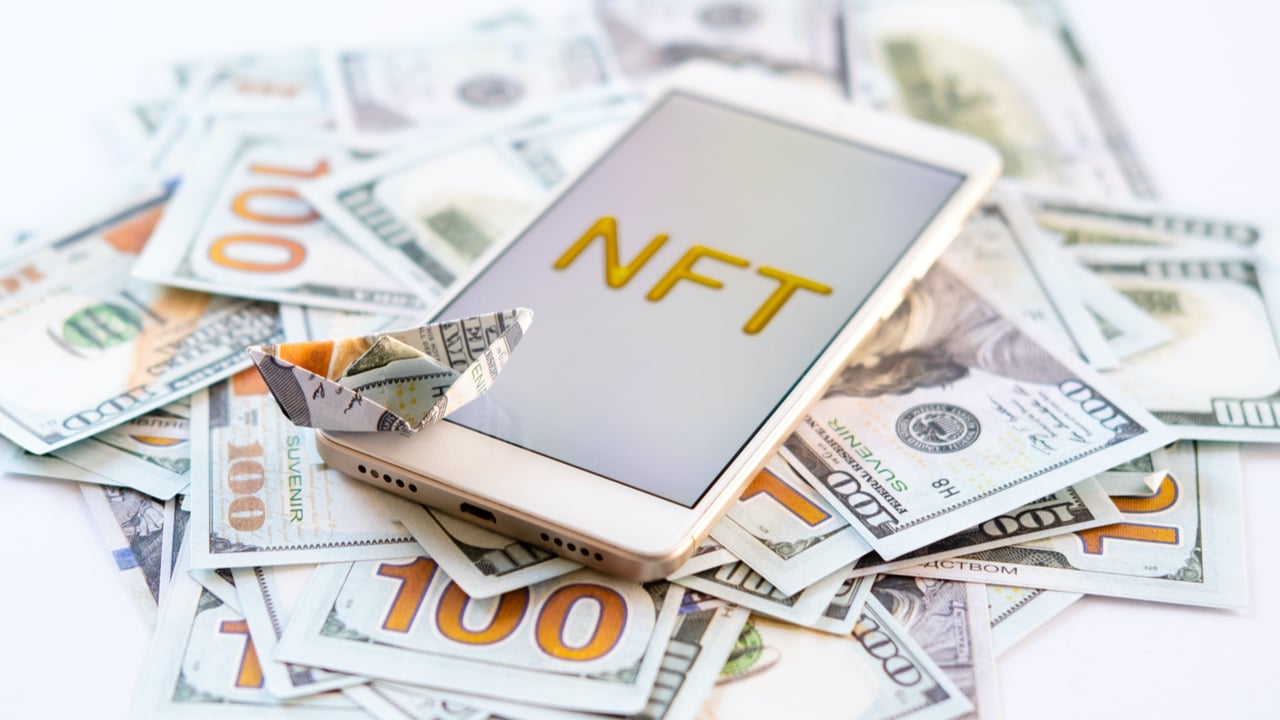
New data from a crypto insights firm reveals that non-fungible token (NFT) collectors have already poured a staggering $37 billion into NFT marketplaces in the first four months of 2022. According to a new blog post by Chainalysis, collectors are on pace to comfortably eclipse the $40 billion that went into NFT marketplaces last year. […]
The post NFT Collectors Sent $37,000,000,000 to Marketplaces in Just the First Four Months of This Year: Chainalysis appeared first on The Daily Hodl.

According to Mark Zuckerberg, Meta was planning to “bring similar functionality to Facebook soon” and working on “augmented reality NFTs” for Instagram as well.
Mark Zuckerberg, CEO of Facebook’s parent company Meta, said that the company is starting to test digital collectibles on photo and video sharing platform Instagram this week, signaling a move toward adding nonfungible tokens, or NFTs.
In an interview with Impact Theory’s Tom Bilyeu published to Facebook on Monday, Zuckerberg said the move to test digital collectibles on Instagram was the first step toward allowing creators and collectors to display NFTs on other apps under Meta’s control: WhatsApp, Facebook Messenger and Facebook. According to the CEO, Meta was planning to “bring similar functionality to Facebook soon” and working on “augmented reality NFTs” for Instagram as well.

The move would seemingly allow Instagram users to display NFTs as profile profiles as Twitter first announced in September 2021 that its users would be able to do and then, rolling out iOS support for NFT hexagonal avatars in January. Reddit said shortly after Twitter’s NFT rollout that it was testing the tokens as profile pictures on its platform, while content subscription service app OnlyFans — which many use to promote adult content — has offered NFT profile pictures since December 2021.
Datareportal reported that Instagram had roughly 1.5 billion users globally as of January 2022, roughly half of Facebook’s 2.9 billion. Many prominent users in the crypto space already have accounts with the photo and video sharing platform, which some hackers have taken advantage of. Cointelegraph reported in April that bad actors breached Bored Ape Yacht Club’s Instagram page and shared links to a fake airdrop with the project’s more than 600,000 followers.
Related: 5 ways nonfungible tokens will transform society
Since rebranding from Facebook to Meta in October 2021, the social media company has announced many initiatives aimed at cryptocurrency and metaverse users. Though Meta shut down its digital currency project Diem — formerly Libra — in February, the company also opened the doors for a brick and mortar metaverse-themed retail store in the San Francisco Peninsula on Monday.

Shiba Inu developer promises a bright future with an upcoming NFT gaming project, but SHIB price continues to fall.
Shiba Inu (SHIB) price dropped by over 10% to $0.00001641 on May 9 amid a broader crypto market decline. This year, SHIB's returns were 50% below zero, one of the worst performances by a top-ranking cryptocurrency in 2022.
Last week, luxury fashion brand Gucci named Shiba Inu in the list of tokens it would accept for payments in five of its U.S.-based stores. Nonetheless, the bulls have ignored the major adoption news as SHIB price continues to fall under macro and technical pressures.

The prospect of Shiba Inu facing more yearly losses increases as it stays on the path toward its "symmetrical triangle" breakdown target near $0.00001197.
The level, which sits around 30% below May 6's price, results from a technical rule that measures symmetrical triangles' profit targets by adding the maximum distance between the structure's upper and lower trendline to the breakout/breakdown point.

Nevertheless, SHIB's shorter-timeframe charts reflects an interim bullish bias.
SHIB has dropped near the red horizontal line near $0.00001667, which has served as an accumulation zone for traders three times since October 2021. For instance, Shiba Inu had rallied by over 100% two weeks after testing the $0.0000167-level as support in January 2022.
The level also coincides with the lower trendline of the descending parallel channel, as shown in the chart below. As a result of this confluence, SHIB eyes a price rebound, with the channel's upper trendline near $0.00002000 acting as the interim upside target for the May–June period.

Meanwhile, SHIB's daily relative strength index (RSI) has dipped below 30, an oversold territory that could further catalyze a short-term rebound.
Nonetheless, macroeconomic catalysts — primarily a hawkish Federal Reserve — continue to pose downside risks for the crypto market, including SHIB. So price rallies are likely to sell off at higher levels, thus keeping SHIB on track toward its triangle breakdown target near $0.00001197.
Shiba Inu's developer Shytoshi Kusama offered a bright outlook for the project in what appeared to be an effort to pent-up the market demand for SHIB tokens.
Related: Shiba Inu has a new use case — Buying land in SHIB: The Metaverse
The developer noted that Playside, an Australia-based video gaming firm, would feature Shiba Inu-themed nonfungible tokens (NFTs) — called Shiboshi — on their upcoming metaverse game of the same name. He also noted that Shiba Inu would release the documentation of their layer-2 blockchain, Shibarium, by "this month or next.''
I updated the Shiboshi chat recently but I'm sure we will be seeing more from Playside soon as we near the final triad of production.
— Shytoshi Kusama™ (@ShytoshiKusama) May 7, 2022
The disclosures came after an Ethereum whale bought 74 billion SHIB (worth $1.23 million at press time).
The views and opinions expressed here are solely those of the author and do not necessarily reflect the views of Cointelegraph.com. Every investment and trading move involves risk, you should conduct your own research when making a decision.
 Sony Group Corporation has revealed it has partnered with Theta Labs in order to launch 3D non-fungible token (NFT) assets. The upcoming NFTs will be crafted for the Sony Spatial Reality Display and are designed for three-dimensional viewing. Sony 3D NFTs to Enhance Spatial Reality Display Features The Japanese multinational conglomerate corporation Sony is working […]
Sony Group Corporation has revealed it has partnered with Theta Labs in order to launch 3D non-fungible token (NFT) assets. The upcoming NFTs will be crafted for the Sony Spatial Reality Display and are designed for three-dimensional viewing. Sony 3D NFTs to Enhance Spatial Reality Display Features The Japanese multinational conglomerate corporation Sony is working […] With the help of the Bored Ape Yacht Club’s Otherside land sale, non-fungible token (NFT) sales have increased a great deal this week. NFT sales increased 74.77% during the last seven days, capturing $1.71 billion in sales volume among 266,918 traders. 7-Day NFT Sales Volume Jumps 74% to $1.71 Billion, Otherdeed NFT Collection Captures $787 […]
With the help of the Bored Ape Yacht Club’s Otherside land sale, non-fungible token (NFT) sales have increased a great deal this week. NFT sales increased 74.77% during the last seven days, capturing $1.71 billion in sales volume among 266,918 traders. 7-Day NFT Sales Volume Jumps 74% to $1.71 Billion, Otherdeed NFT Collection Captures $787 […]
The company will release tools to swiftly upgrade mobile Web2 games in compliance with Apple and Google app store rules.
Ready Games, provider of developer and creator tools for the Web3 community, will launch a new ecosystem with the goal of incentivizing Web2 game creators to explore and switch to Web3 with minimal development time and cost while distributing games “as normal” through traditional app stores.
On Friday, the company announced the launch of the ecosystem that will include the utility token AURA and a set of developer tools, specifically aimed at bringing mobile Web2 games into Web3 in compliance with Apple and Google app stores’ rules. This process took only five days in the ecosystem’s Alpha version, Ready Games claims. As the release goes:
“The ability to quickly integrate a shared utility token- $AURA- allows devs to seamlessly go live with a compliant web3 game, and get immediate learning on how web3 gaming can bring value to their gaming portfolio”
The ecosystem will also allow artists to create and upload styles and gadgets to be purchased and traded within Ready’s games, while players will be rewarded in an “indirect way.”
Related: The creator economy will explode in the Metaverse, but not under Big Tech’s regime
Some major game guilds, including the five million-strong SnackClub, have already partnered with Ready to participate in the ecosystem. Ethan Kim, co-founder & partner at Hashed, also confirmed the partnership:
“We are excited to partner with Ready in building the leading Web3 mobile gaming and user-generated content ecosystem. Along with Ready’s ability to seamlessly onboard a wide spectrum of games and content, their in-depth understanding of developers, creator communities and players will accelerate mass adoption of blockchain-based gaming.”
As specified in Ready’s FAQ, blockchain-based games are not banned from Apple and Google app stores per se. Complying with Apple and Google rules means that the app platform providers must get their commission from any NFT-backed in-game purchases, and that game creators must avoid in-app links to external means to purchase in-game assets.

How can fashion and crypto mix in a practical yet innovative way so that even Phillip Plein’s mother can understand crypto and NFTs?
In an attempt to bring the fashion industry into new innovations and trends, many brands are entering the cryptoverse to test out the waters. Fortunately, the crypto industry has its arms wide open, ready to accept the fashion world and grow.
One fashion designer who has recently started dipping his toes in the crypto world is Philipp Plein. He participated in Decentraland’s Metaverse Fashion Week, showcasing a collection alongside Dolce & Gabbana, watch company Jacob & Co and many others who joined Decentraland in an attempt to bring fashion and the Metaverse together. During the show, Plein used the skull that is so apparent in his brand to not only present the models but showcase his work.

Cointelegraph stopped by the launch event for Plein’s new Museum of NFT Art concept store, which brings his brand into the crypto industry and showcases how it plans to take a fashion-forward approach to crypto — in style and in the heart of London.
It wasn’t just Metaverse Fashion Week that got Plein into crypto. In 2021, something sparked within him. “There was no built plan. It was just everyone was talking crypto, everyone was saying it was cool, and it was happening. I didn’t have any vision,” the designer told Cointelegraph.
Regardless, he discovered that his vision was to help people like his mother understand and participate in the crypto industry — but to make it high fashion and ensure that it’s truly accessible for everyone.
Plein first started accepting crypto in his online shops, but the payment option was soon introduced to the brick-and-mortar stores around the world as well, allowing anyone to take advantage of the new technology. Garments in the stores have QR codes that, when scanned, direct the prospective buyer to a website that shows how much they cost in British pounds, Bitcoin (BTC), Ether (ETH) and TerraUSD (UST), among the other accepted cryptocurrencies.

When asked how exactly the brand organizes 25 different cryptocurrencies plus the local currency, Plein told Cointelegraph that “We’ve developed a very complex way to do it. Every 10 minutes, we update the exchange rate on the website. So, if you go on the website and click on the sneaker to know the price, every 10 minutes you will get an updated price. So, we are getting really close to the actual price of the moment.”
But what if you want to return the product and the price of Bitcoin has increased? Plein has come up with a solution. “If you want to return it in a month or two, we will give you the same value of what you spent in the currency in the country you live in. For example, if you buy this for 100 pounds, which is 1 Ether, and in three months ETH goes up, you will get 100 pounds back.”
Plein wants to make the onboarding processing easier. As such, the offline stores cultivate an environment where everyone can learn about crypto through an application developed by Plein and his team. Sales associates are there to answer questions and provide insight on how Philipp Plein and crypto are a match made in fashion, bringing everyone interested into the crypto community without any of the intimidating parts. Plein added:
“I have to make it accessible for my mum, so that is my vision and my mission.”
The event was put together to celebrate the opening of the Museum of NFT Art, or MONA. On the third floor of Plein’s London shop, he invited guests to view a presentation of his nonfungible tokens. He showcased NFTs of monster figures along with screens that displayed his products. Here and in his stores, Plein wants to be “the one who makes you own your first NFT.”

The Museum of NFT Art was built in-house because Plein does not “like to work with agencies. So, I created my own publishing house and started to work with the people. Now, we pick our own team and offer our services for free.”
The issue with other NFT platforms is the fees, he said. But Plein sees NFTs and onboarding people differently: “We don’t aim for money. We make our money with our products. We developed this platform for our needs, and now we make it accessible for other people.”
The NFTs can be bought in-person via a sales association, but this is only one part of what customers experience when visiting the MONA London shop. He aims to provide a variety of ways for users to experience NFTs that can help anyone with any level of crypto knowledge.
“People started to be interested, but they weren’t able to pay with crypto because they didn’t have crypto. They started to ask, ‘How could we get a Philipp Plein NFT monster?’ And then we started selling them from the website like a shoe. You can pay with a credit card, Apple Pay — you can pay with whatever you want, and then we send you the NFT. And this was interesting. We sold about 1 million in NFTs in two to three months.”
On top of a direct credit card or Apple Pay purchase, NFTs can also be bought with cash. “I’ve never heard of paying for an NFT in cash. So, if you want to come to London, you can pay in cash.” He wants to make NFTs accessible “to my mother, who will never buy an NFT.”
As a cherry on top of this innovation in the ever-changing NFT market, Plein laid out his biggest issue with NFTs: gas fees. “They sell you the NFTs, and then you have to pay gas fees,” He added: “Explain to my 67-year-old mum what a fucking gas fee is.”

So, Plein decided to bunch together the NFT’s price and the gas fees so that customers don’t have to think about it. Indeed, with reports of Yuga Labs’ Otherdeeds NFTs spiking some gas fees up to 5 ETH, the issue presents a huge problem, one that many don’t anticipate. “Some people see 10 euro shipping and will not even buy the product because they have to pay for shipping. We will sell all of our NFTs at a price that includes the gas fee, so you don’t have to think about it.”
As part of the running joke of what one can actually do with an NFT, another part of the Plein NFT experience includes a picture frame, or hardware for a wall, and even a Christmas tree ornament. Anyone has the chance to hang their Plein NFT right next to their favorite ornaments, and maybe Santa will bring one that can be burned into a wearable in Decentraland.
“So, my mum, who now has an NFT, asks, ‘Well, what do I do with it?’ Okay, mum, now you hang it on your wall.”
Cointelegraph asked Plein about the future of the Philipp Plein brand and its Metaverse endeavors — in particular, how he mixes his personal ideas with both his real-life and Metaverse brand.
According to Plein, fashion is one of the toughest industries imaginable, one where “You have to reinvent yourself from zero several times a year. Each season, the trends are so unpredictable, and the consumer is very hard to control in regard to these unpredictable seasonal trends.”
Plein has himself tried out many new things to see what sticks, not only with Metaverse Fashion Week but also with his spring/summer 2022 campaign with Megan Fox and photographer Stephen Klein. “The only way to work with this is to be open-minded, to be experimental, and to try new things to understand what the consumer likes.”
Plein also sees the Metaverse as a way to explore trends to see what will stick. He believes that while “The Metaverse is not there yet, it’s not going to take too much time, maybe three to five years, because the technology is much faster now than in the past.”

Gucci’s past efforts into Web3 have culminated with the brand accepting 12 cryptocurrencies at a few select stores, with a wider rollout planned for the future.
The Italian high-end fashion label Gucci has announced it will begin accepting cryptocurrency payments by the end of the month in five of its United States stores, with plans to extend the service to all of its 111 stores in North America.
Gucci will accept 12 cryptocurrencies including Bitcoin (BTC), Bitcoin Cash (BCH), Ethereum (ETH), Wrapped Bitcoin (WBTC), Litecoin (LTC), Shiba Inu (SHIB), Dogecoin (DOGE) and five U.S. dollar stablecoins according to Vogue Business.
Customers paying with crypto in-store at the pilot locations in New York, Los Angeles, Miami, Atlanta and Las Vegas will be sent an email with a QR code to pay via their digital asset wallet. Employees have started to undertake training and education on crypto, non-fungible tokens (NFTs) and Web3 in preparation for the launch.
Gucci has recently been on a Web3 adoption spree with two NFT collections launched in 2022 — the “SUPERGUCCI” collection in February in collaboration with toy brand SUPERPLASTIC, and the “Gucci Grail” collection in March targeting owners of existing blue chip NFT projects such as Bored Apes, Pudgy Penguins and World of Women.
Its first ever NFT was a 4-minute film titled Aria that took inspiration from its clothing collection of the same name that sold for $25,000 in June 2021 in an online auction hosted by Christie’s.
Gucci has further expanded into Web3 through its purchase of virtual land in The Sandbox in February developing a virtual retail experience mirroring its Vault e-store.
Believe in the power of imagination, @gucci #GucciVault pic.twitter.com/NnHtF7kqk1
— The Sandbox (@TheSandboxGame) February 9, 2022
The Gucci Vault is an online concept store representing “Gucci’s presence in the Metaverse” featuring a curated selection by its Creative Director of rare vintage Gucci pieces.
Related: Is there a future for digital fashion in the Metaverse?
High-end brands have been jumping into the crypto and Web3 space. In March the fashion label Off-white started accepting payment with six cryptos in its flagship stores in Paris, Milan and London.
Off-white is majority-owned by LVMH which has seen its share of Web3 adoption, releasing NFTs under its Hennessy, Bulgari and Louis Vuitton brands in the past.
LVMH’s luxury watch brand Hublot released a limited edition collection that could only be purchased using Bitcoin, more recently the brand partnered with cold wallet provider Ledger launching a limited edition watch and Ledger Nano X in February.
Watch brands Franck Muller and Norgain along with fashion label Phillip Plein all accept crypto, and even car dealerships and car manufacturers are accepting digital assets for high-end vehicles.
The luxury fitness company Equinox Group started accepting crypto payments for its New York City based clubs on May 3, with yearly memberships starting just under 1.4 ETH or $4,044.
 Following one of the largest non-fungible token (NFT) mints in history and after apecoin transactions from the sale fueled Ethereum network fees, apecoin is now integrated with the Polygon (MATIC) network. On May 2, the Apecoin project announced that with Polygon support, APE is now available via MATIC’s 19,000 decentralized applications (dapps) and games. Apecoin […]
Following one of the largest non-fungible token (NFT) mints in history and after apecoin transactions from the sale fueled Ethereum network fees, apecoin is now integrated with the Polygon (MATIC) network. On May 2, the Apecoin project announced that with Polygon support, APE is now available via MATIC’s 19,000 decentralized applications (dapps) and games. Apecoin […]